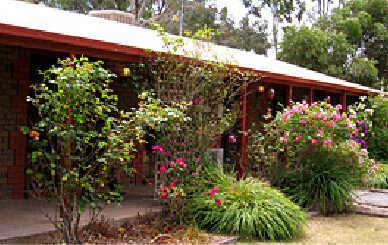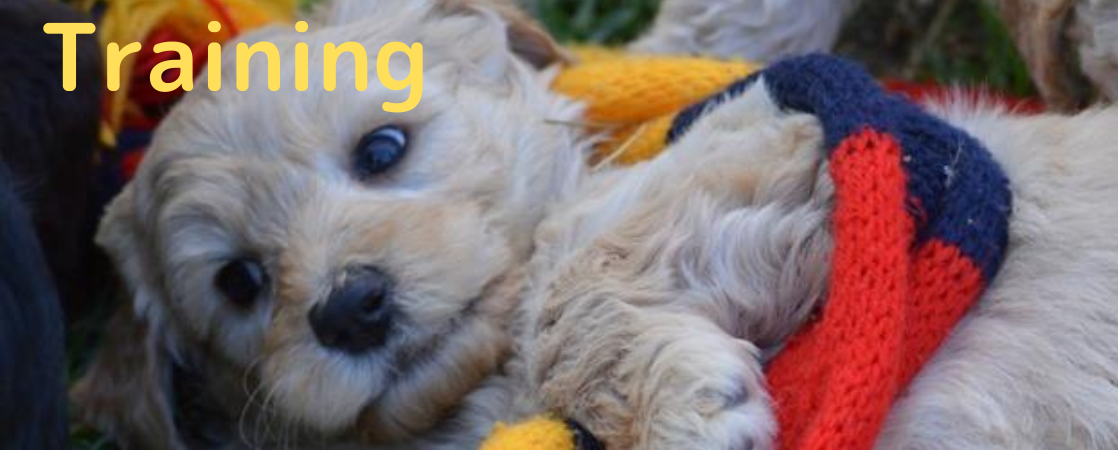
Introduction
Your puppy is ready to begin being trained at 8 weeks of age.
You will want to start out with simple tasks at first and do not add another task until the first has been conquered.
Good vs. Bad
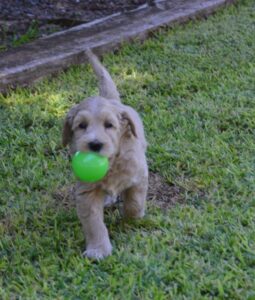
Your dog is neither “Good” or “Bad” in the moral sense of the words. He is what you make of him with the training and rules that you set and the consistency you use.
Remember you may hate to have your dog jump up on your furniture while another owner may love to have his furry friend snuggling on the couch with him while he watches the TV.
What determines your idea of a Good vs. Bad dog is up to you, and the training required to create that “Good” dog is your responsibility.
Who Should do the Training?
Only one person should oversee your puppy’s training (preferably an adult or mature minded person.)
Each person in your home is an individual with different voice tones, inflections and expect different responses even if minimal from your puppy. Multiple trainers will cause your puppy confusion.
NEVER play or allow children to play the game of multiple people or children calling the puppy to “see who they’ll come to.” This is confusing and very unfair to your puppy, as your puppy will have established relationships with everyone in the family and won’t know what to do.
Whoever is chosen for the “job” of training the puppy should be mature enough to handle the responsibility.
Remember one of the Key Elements to training is Consistency, so the person training should probably be the person who spends the most time with the dog (If that person is also mature enough to do the training.)
Daily Training
Ten minutes training daily is better than longer sessions off and on, remember consistency is the key.
Your dog will enjoy these “training sessions” and will look forward to learning, practicing and working for you.
Training sessions should be no more than 35 minutes. A 25-minute session is fantastic, but even with 10 minutes a day, the results will pay you back for the time you spent in multiples.
Training Policy
The followings are the basic policy you need to keep in your mind giving daily training to your puppy.
Positive Reinforcement Training
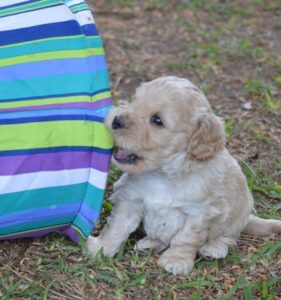
We have found from experience that Positive Reinforcement Training is one of the best tools to use when training your puppy.
When your dog does a good job or has made you happy, use a happy voice and tell him what a Good Dog he is. Give him pats, scratches, snuggles and even treats to help reinforce the “Want to Please” trait in your puppy.
If your puppy is doing something wrong, use your upset voice to tell them “NO! Bad Dog!” A lot of dogs will respond from being praised and punished with your voice inflections and tones alone.
Consistency
This is the key element of any training goal you might have for your dog. Without consistency, you will never accomplish a well-trained dog.
Remember your dog doesn’t understand that you let them jump up on the couch yesterday and not today, because yesterday he was nice and clean, but today he has muddy paws. In the same line of thinking, your puppy will not understand if yesterday he was able to jump up on you but not today, because you are in your “nice clothes”.
Remember that you must be constant with your training and what you allow and don’t allow and avoid “changing the rules”.
Part of the Pack
Your puppy will come to you, wanting to please you from the very beginning. This is a wonderful trait, and you, as the Master/Mistress and trainer, should use this trait to help with your training him.
You and your family have now become your new puppy’s “pack.” This is a natural and good trait in your dog.
Even though your sweet little puppy is now a domesticated family companion, he is still the descendants of wolves and are strongly affected by pack behaviour and hierarchy within the pack.
When a dog “joins a new pack,” the whole pack usually has to work out the pack hierarchy again, as he will usually “challenge” his placement within the new pack to find out what is the working order.
You need to keep in mind that, no matter what, you are the pack leader and your family’s placement will always be above the new addition (your puppy).
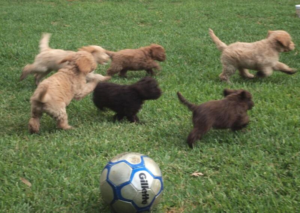
If you do not set the “pack rules” and hierarchy of your “pack,” your puppy will assert himself as the pack leader, as he would naturally do. Your puppy should NEVER be your pack leader. They must be the lowest in the pack hierarchy. Your puppy is well tuned into pack hierarchy even at this young age.
He has been learning from his mother, siblings and other dogs, where and how he is placed in the pack hierarchy. When your puppy was doing something that, in their Mummy’s eyes, was naughty, she would discipline him.
He has been with his Mum for several weeks now and he knows the “pack” rules. When his Mum disciplined him, she would grab him by the back on the neck, shake him and lean on him until he rolled over on his side or back and completely stopped struggling and relaxed, while she was doing this she would growl loudly at him. This is exactly how your puppy has learned where his placement was and what is acceptable in the pack.
Since your puppy’s Mummy has already “taught” him how to be submissive to the pack leader, you are able to use the same tools to establish yourself as the pack leader.
If your puppy challenges your dominance by growling, nipping etc… right then and there, you MUST grab him by the back of the neck, give him a little bit of a shake and make him either lie on his back or side all the while growling loudly.
DO NOT let your puppy up until they give in and COMPLETELY relax. It is very important to keep a hold and continue to growl until he goes “limp”. When he does this, he is showing that he is completely submissive to you and will accept that you are dominant.
For some puppies, you will only need to do this once, if at all, while other puppies might need you to consistently do it for a short time until you have completely established your and your family’s dominance and pack hierarchy.
“As the leader of your pack you have the responsibility to Protect, Love, Care, and
Discipline your pack. Your puppy will accept and benefit from this pack structure and hierarchy. He will look to you for Love, Protection, Care and even Discipline. “To Please” his Master/ Mistress/Pack Leader is one of the most natural traits in your puppy and is why dogs are known as “Man’s Best Friend” and why they have such a special place in our hearts.”
To Punish or Not
You walk into a room and you have found a misdeed done by your dog!
You are instantly aware of who the culprit is, and in your anger, you call your dog to come to you! Your dog comes and has that “guilty look,” so you think he knows what he did was wrong and proceed to punish him for the misdeed.
While you feel that you have rightfully punished your dog for his misdeeds, you have just done the very worst thing possible.
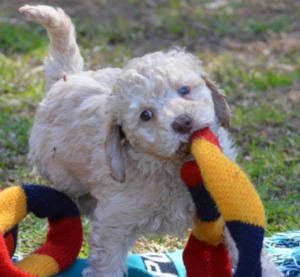
You have punished your dog for coming! Dogs work in the here and now mindset and the last thing your dog remembers doing is coming directly to you when you called. But he had that “Guilty Look.” So, you assumed that he must have known that I had found what he had done wrong.
Not so. The Australian Labradoodles are very intelligent, and therefore, they are very tuned into your emotional state. Because of this, not only has he sensed the tone and inflection of your voice but also your body language as soon as he entered the room and understood that you were very upset about something.
So that “Guilty Look” is quite simply the fact that your dog is closely tuning into your body language and voice inflections and tones, but not that they knew what they have done was naughty.
If you catch your dog “in the Act” of a misdeed, then by all means, punish them for that current act, as that is what is fresh and current in his mind.
How to Talk to Your Dog
Keep your words and requests short and to the point.
When giving your dog command, try and keep the same tone and voice inflection every time the command is made. Usually you will want to use the dogs name before each command to make sure you have his attention, for example “Fido SIT”, “Fido COME”, “Fido STAY” etc…
When using voice inflection, remember that the more excited and higher inflection is an encouragement and sign of excitement to your dog. While a deeper soothing and quiet inflection is used to encourage, quiet and soothing their movements.
Simple Commands
“NO,” spoken deep, sharp and commanding, means stop what he is doing this instant.
As soon as your dog responds properly to the command by stoping or even pausing and thinking about stopping, give him a “Good Dog” Positive Reinforcement in a higher and happy voice inflection.
By doing this you are “rewarding” your dog’s intention to stop and listen, even though the action of following through may not yet occurred.
If the dog turns back and continues the wrong behaviour, repeat the command “NO” even deeper and more sternly and start walking towards your dog.
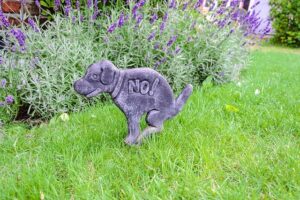
Once you have your dog’s attention back on you, instead of the misdeed, make sure you use the “Good Dog” Positive Reinforcement, even if you would like nothing better than to rant and rave at what he has done.
The Goal of the “NO” command is to have him instantly stop. So, once you have his attention and not on what he was doing, he is to be praised. Remember Consistency.
“Drop”, “Release”, “Leave” and “Back”, are excellent commands to teach your dog when you wish for him to drop something that he has in his mouth, he was bothering, or he needs to get back from something.
This can be used when teaching your dog to fetch, when he is chewing on something he shouldn’t, when you are feeding him and want him to get back etc… The response should be that he instantly leaves alone or drop what ever it is that he was chewing on, holding, or bugging.
Food bowl training is a good way to teach the “Back” or “Leave” command.
Place his food bowl (with food) on the floor and make him sit while restraining him and say “Back” or “Leave”. Continue to repeat the command (consistency) every time he moves. When he remains still, give him the “Good Dog” Positive Reinforcement.
Release your dog only when you are ready, if he tries to break or move before you release him, you have to again give the “Back” or “Leave” commands until he is quiet and you are ready to release him.
When you release him, ALWAYS give him the same command “OK” or “Release.”
You should end up with a dog that goes, sits and waits for you to release them to eat without even having a hand on them (after they have learned the command).
“SIT”, Spoken in a firm down inflection commanding voice should results in your dog sitting instantly. To achieve this, you will pull the lead straight up and push his hind end down so that he is in the sitting position while you repeat the command “SIT.”
Once he is sitting, give him the “Good Dog” Positive Reinforcement and shower him in praise showing your pleasure even if he only sat for a few seconds.
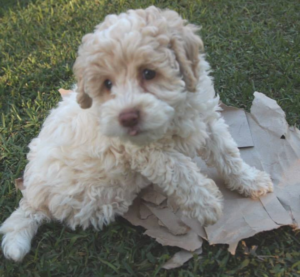
Always give your puppy a chance to respond to the command, before you physically help him follow it. You may have a nice surprise as he might just do it on his own after the first session! Don’t forget the Positive Reinforcement!
“Drop” is a command that requires your dog to lie down instantly. This is a command that you will teach after the “Sit” command. The “Sit” command gets you halfway to “Drop”.
To accomplish this first, ask your dog to sit, then make a downward motion with your hand and, if necessary, tap the ground/floor.
Make sure that he doesn’t stand up from his sitting position. He should move from the “Sit” to the “Drop” without lifting his hindquarters. In the beginning you may have to rest one hand on his hind end while using the other to tap the ground/floor or pull directly down on his collar continuously using the “Drop” command. As soon as he lies down even for a few seconds, remember to give the “Good Dog” Positive Reinforcement.
“Stay” is a command that means the dog is to stay motionless wherever he is even if you step away from him. When starting this training, never move the foot closest to your dog as your first step as this will encourage the dog to “follow” you.
Use the foot farthest away while repeating “Stay” using the foot closest to the dog is a universal command to follow. Place your hand flat with palm towards your dog directly in front of his nose and face repeat “Stay”. Start with small distances (a couple of steps) and for short time periods (seconds) to begin with.
“Heel” or “To Me” this command is used when your dog is on the leash or you wish for him to walk or come to your side (usually the left).
“Heel” is the opposite to the concepts used in the “Stay” command. Start using this command while your dog is on the leash. Take your fist step forward with the foot closest to the dog. This indicates that the dog is to follow.
If you are using the slip chain, use the command “Heel” or “To Me” when you tighten up the slip.
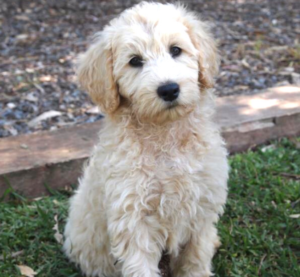
Remember that if your dog is pulling, do not “pull back.” Do sharp little jerking motions and then instant release even if it is several times in a row to get him to heal and walk on a loose lead by your side.
Sometimes just taping your thigh and giving the command “Heel” or “To Me” will remind them that he is to walk on a loose lead by your side.
“Down” or “No Jump”, this command is used to make your dog instantly stop jumping up or on you.
To accomplish this, you may have to go back to the basics using the lead jerking it downwards and using the “No Jump” or “Down” command with a stern and sharp command.
Step into the dog when doing this, NEVER get away which encourages them to come forward and up instead of down.
As soon as the dog’s front feet touches the ground, give the “Good Dog” Positive Reinforcement, even if it was accidental on his part. This may take several times in a session or multiple sessions.
Don’t get discouraged. Remember when your dog’s feet are back on the ground to be calm, reassure and use quiet hands as this will calm your dog.
If you get too excited about them being a “Good Dog,” it will encourage them to get excited and subsequently jump up again.
When to give commands
Never give your dog a command that, if not obeyed, you cannot follow through with.
It is usually more detrimental to your dog if he learns that he can get away with not acting on a command, than actually getting away with a misdeed once or twice (life threatening situations of course require you to sometimes give commands when you are unable to reach or get to your dog).
Ignoring a command is a habit that you want to avoid, as it is very hard to undo and can cause all the training you have put into your dog to be of no use.
Types of Training
The followings are basic training you need to give to your puppy as soon as he/she becomes ready for the training.
Potty Training
Your puppy’s success in potty training is largely based on your consistency in training them. If done properly, it can be a very quick and easy learning process.
Puppies do not like to potty near where they sleep or eat. Confining your puppy to a small area (their crate/kennel) or a partitioned off area helps. It’s best not to let your puppy have free roam of the house until potty training has been completed.
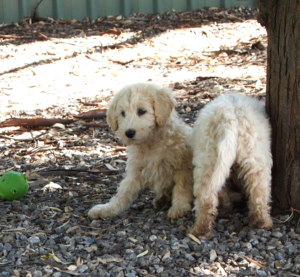
Puppies will seek out the place where they last pottied. So, if you see your puppy sniffing around, scoop him up and take him out to where you wish for him to potty.
Remember that they will seek to potty in the same spot they last pottied, so any mistakes that have been made will cause the potty-training process to take longer.
If your puppy has an accident in the house, you DO NOT want to clean the area up with any product that has Ammonia. Ammonia smells like urine to your puppy and will encourage him to potty there.
Pet Supply stores have several different products you can purchase for cleaning the accidents. One recommended product is a Pet Urine Absorbing Powder. This product is sprinkled on the area and then absorbs the moisture and smell, and once dried is vacuumed up. If a cleaning product is needed, try and use Natural (non-ammonia) cleaners.
The best way to succeed in potty training is to keep a close eye on your puppy in the first few days and as soon as you see signs (sniffing around) take him out to where you wish for him to potty.
Remember your puppy will need to potty during the nights at first too. If you wake to puppy crying (if they have been asleep), he probably needs a potty break.
Hints: As soon as your puppy wakes from a nap, take him out for a stretch and potty. About 5-20 minutes after eating, take him out for a stretch and potty, and regularly throughout the day, especially if it’s been awhile since his last potty break.
Mouthing or Nipping
Your puppy should NEVER be allowed to “Mouth” or “Nip” at anytime.
All puppies must be taught that this in unacceptable. We have found one of the best teaching tactics for this is to set you hand on the top of the puppy’s nose, wrap your fingers around the top muzzle with his lips between your fingers and his teeth. Then give a squeeze and at the same time give the command “NO BITE! “
Soon your puppy will realize that every time he mouths or nips you, he ends up biting his own lips and should learn very quickly not to do so in the future. Remember Consistency.
Naps
Remember your puppy is still a baby and still needs uninterrupted naps during the day.
Just like little children, puppies get tired and cranky if they go too long without a nap.
Make sure that you give your puppy an opportunity to take naps even if that means putting the puppy in another area (crate is useful), so that your family’s activities don’t disturb him while he sleeps.
Exercise the Mind
Your Australian Labradoodle is an extremely intelligent dog who just like a gifted child who needs mind stimulation.
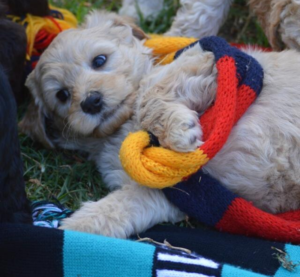
Because of this, you will need to help your dog stimulate his mind with “Good” tasks. If you do not give your puppy enough mental stimulation, he will come up with his own tricks and habits to stimulate his mind. We are sure we do not need to point out that his idea of fun mental stimulation will probably not be your first choice.
Once the basics of training have been achieved, your puppy will probably enjoy being taught to do tricks and tasks for you. Such as fetching balls and sticks, bringing in the newspaper, “guarding or watching” something for you, lying in a special spot next to you while you relax in the evening etc…
Bonding
It has been well proven that it is not the one who gives affection and/or feeds the dog, but it is the trainer who is rewarded with the strongest bond with the dog.
That’s right, just as his Mummy was the one who was his disciplinarian and pack leader for a young puppy, you have filled that role.
Dogs and Puppies, from a very early age, seek to have approval, acceptance and seek to please within their pack and now within your homes and families.
It is your responsibility to train a “Good” dog based on your personal requirements and to give the dog the attention, consistency, and ability to know his placement within your family.
Doing this will ensure that your pet feels stable and comfortable in his placement with your family.
